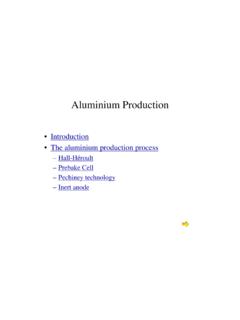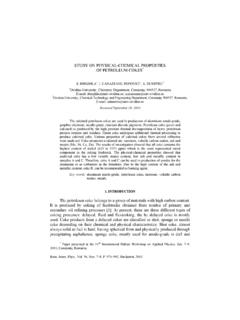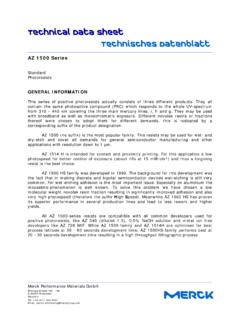Transcription of RESEARCH REPORT 068 - Health and Safety Executive
1 HSE Health & Safety Executive Cancer risk following exposure to polycyclic aromatic hydrocarbons (PAHs): a meta-analysis Prepared by the London School of Hygiene and Tropical Medicine for the Health and Safety Executive 2003 RESEARCH REPORT 068 HSE Health & Safety Executive Cancer risk following exposure to polycyclic aromatic hydrocarbons (PAHs): a meta-analysis Ben Armstrong, Emma Hutchinson, and Tony Fletcher London School of Hygiene and Tropical Medicine Keppel Street London WC1E 7HT We carried out a review and meta-analysis of published reports of occupational epidemiological studies quantitatively informative to the PAH-cancer (lung and bladder) relationship.
2 On average over 39 included cohorts, the estimated unit relative risk (URR) at 100 mg/m 3 years BaP was (95%CI: , ) for lung cancer , and was not sensitive to particular studies or analytic method. However, the URR varied by industry. The estimated mean in coke ovens, gasworks, and aluminium production works were similar ( ). Average URRs in other industries were higher but imprecisely estimated, with those for asphalt ( ; ) and chimney sweeps ( ; CI: ) significantly higher than the above three. There was no statistically significant variation of URRs within industry, or in relation to study design (including whether adjusted for smoking), or source of exposure information.
3 Limited information on total dust exposure did not suggest that dust exposure was an important confounder or modified the effect. For bladder cancer (n=27), the average URR was (95%CI: , ), with no statistically significant variation by industry or other putative determinants. However, numbers of cases were small in most studies, and results were highly dependent on two large studies of aluminium production workers. This REPORT and the work it describes were funded by the HSE. Its contents, including any opinions and/or conclusions expressed, are those of the authors alone and do not necessarily reflect HSE policy.
4 HSE BOOKS Crown copyright 2003 First published 2003 ISBN 0 7176 2604 0 All rights reserved. No part of this publication may be reproduced, stored in a retrieval system, or transmitted in any form or by any means (electronic, mechanical, photocopying, recording or otherwise) without the prior written permission of the copyright owner. Applications for reproduction should be made in writing to: Licensing Division, Her Majesty's Stationery Office, St Clements House, 2-16 Colegate, Norwich NR3 1BQ or by e-mail to ii Acknowledgements The authors are grateful for investigators of the included studies for providing additional information when it was requested.
5 Iii iv CONTENTS Executive vii 1 1 2 3 LITERATURE 3 LITERATURE SEARCH 3 EXPOSURE ESTIMATION .. 4 Cumulative exposure.. 5 Dust 5 STATISTICAL ANALYSIS .. 6 Estimation of unit relative risks (URRs).. 6 Selection of exposure contrasts for estimation of 6 Meta-analysis .. 7 3 9 LUNG 9 Study characteristics .. 9 Unit relative risks .. 9 Publication bias .. 10 10 Sensitivity analysis .. 10 BLADDER 11 4 DISCUSSION .. 13 LUNG 13 Possible 13 Explanations for variation in 14 Comparisons with other studies.
6 15 Interpretation for risk 16 BLADDER 16 METHODOLOGICAL 18 A: studies included in meta-analysis .. 19 B: Other 21 TABLES and FIGURES .. 23 Table 1: Main supplementary exposure estimates (BaP; total dust).. 23 Table 2 Cohort characteristics and unit relative risk estimates: Lung 24 Table 3: Summaries of cohort characteristics (lung cancer)..25 Table 4 Distribution and determinants of unit relative risks for lung cancer ..26 v Table 5 Investigating the dependence of Mean URR on high 27 Table 8 Special investigation of prebake aluminium potrooms to inform on potential confounding Table 9.
7 Relative risks for contracting cancer estimated to follow from 40 years occupational Table 6 Cohort characteristics and unit relative risk estimates bladder cancer .. 28 Table 7 Distribution and determinants of unit relative risks for bladder 29 by dust.. 30 exposure .. 31 Figure 1: Relative risk at 100mg/m3 years (URR) for lung 32 Figure 2: Relative risk at 100mg/m3 years (URR) for bladder 33 APPENDICES .. 34 Appendix B1: Summary of information on PAH exposure (as BaP) in published epidemiological Appendix B2: Review of PAH exposure information pertaining to studies for which this was not Appendix B3: Supplementary estimates of PAH(BaP), for studies in which these were not provided Appendix A.
8 Specific search terms used to identify 35 36 provided by the 37 by the 44 Appendix B4: Total dust exposure in included industries: a review ..48 Appendix C. Estimating unit relative risk increments .. 51 Appendix D: Description of individual studies (by industry) .. 54 Appendix E: meta-data on exposure-response (lung cancer preferred contrasts).. 61 vi Executive SUMMARY Background: Airborne PAHs have long been known to cause cancer in animals and have been widely classified as known human carcinogens. We carried out a review of published reports of occupational epidemiological studies quantitatively informative to this relationship, and a meta-analysis to identify the average and determinants of lung and bladder cancer risk per unit exposure.
9 Methods: Relevant peer reviewed reports published up to early 2001 were identified systematically using bibliographic databases. We excluded cohorts exposed occupationally to known or suspected carcinogens other than PAH that may have lead to substantial risks (eg foundries, diesel exhaust exposed, rubber) were excluded. From each study that met the inclusion criteria (n=39), unit relative risk (URR: relative risk at 100 mg/m3 BaP years cumulative exposure) was estimated by loglinear Poisson regression from published tables of risk against estimated cumulative exposure.
10 For slightly more than half the studies, this required published data to be supplemented by estimated concentrations and sometimes duration of exposure. This exposure estimation was based on a review of published exposure data carried out by an industrial hygienist. Distribution and determinants of URRs were investigated using standard meta-analytic methods. Results: On average, URR was (95%CI: , ) for lung cancer , and was not sensitive to particular studies or analytic method. However, the URR varied by industry. The average in coke ovens, coal gasification and aluminium production works were similar ( , , respectively).















